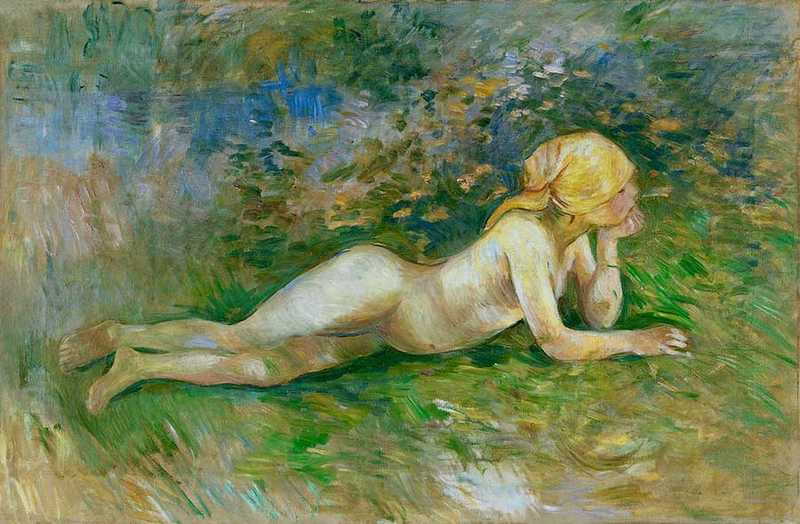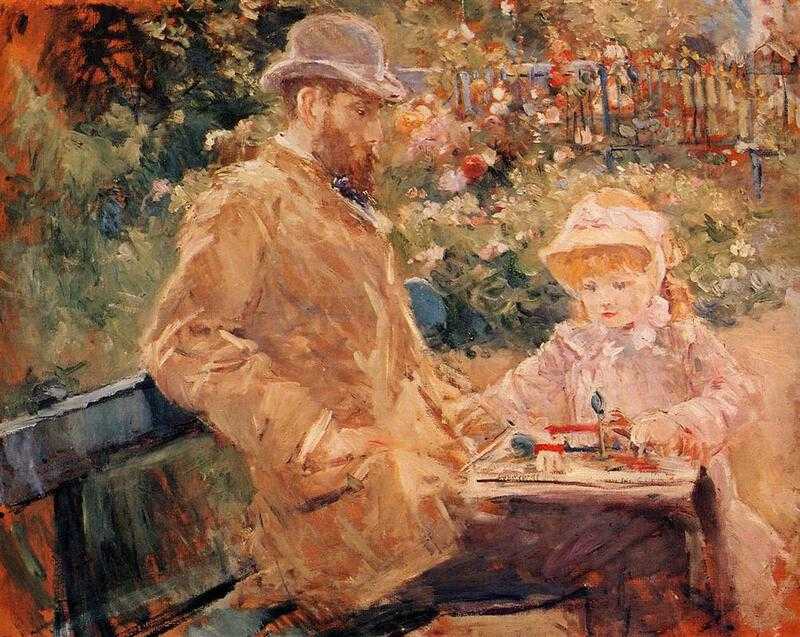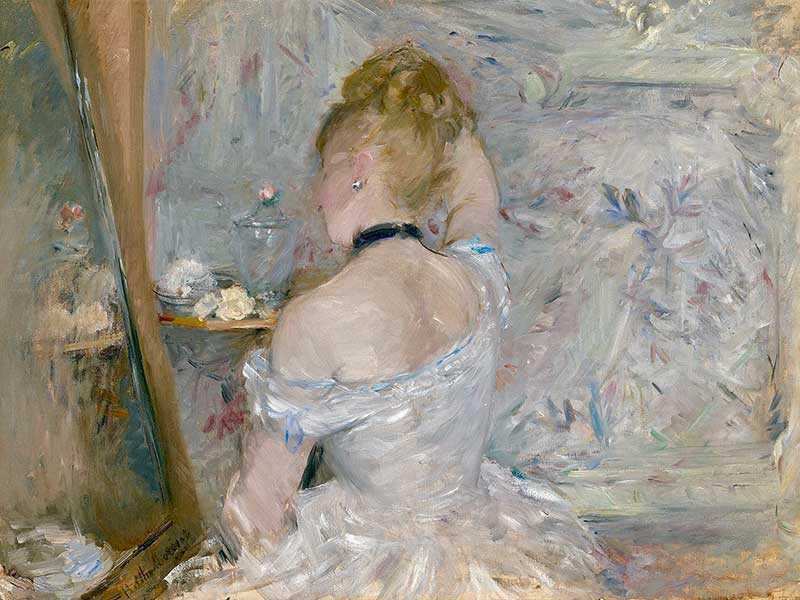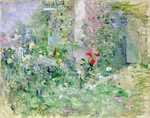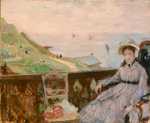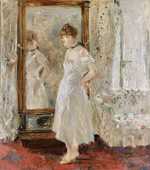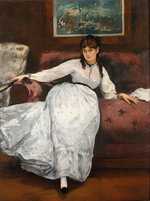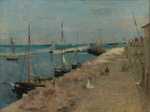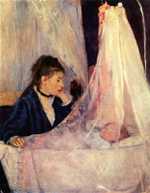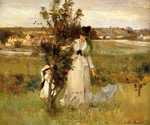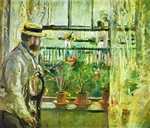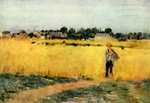1. Early Life
Berthe Morisot was born in a family that valued art.
She was the granddaughter of the French Rococo painter Jean Honore Fragonard (1732-1806) and received support and encouragement for her artistic ambitions from both her parents, especially from her mother, Marie Cornélie Morisot. She thought that her daughters should become professional painters, and both Berthe and her sister Edma were provided with an education in art. Her father was a student of the Ecole des Beaux-Arts before becoming a high-ranking government official.
1841: Berthe Morisot is born on 14 January in Bourges, France to a well-off family. Her siblings include two older sisters, Yves and Edma, and one younger brother, Tiburce.
1852: Before she turns 12, the Morisot family settles in Passy on the outskirts of Paris. Before that, the whole family had to move because of their father’s work. It was to be her abode for the rest of her life. Passy became a part of Paris in 1859; prior to that it was a country district.
2. Morisot’s Art Career
1857: Berthe and Edma receive their first formal art education from Geoffroy-Alphonse Chocarne, a portrait and history painter. They are also tutored by Joseph-Benoit Guichard, a well-known artist from Lyon. At the start of her career, she is inspired by the works of classical landscape artists such as Jean Baptiste Guillemet.
Interesting fact...
When the Morisot’s took their daughters for an art education to Guichard, he let them know that continuing their studies in art could be a problem later on: "Given your daughters' natural gifts, it will not be pretty drawing-room talents that my instruction will achieve; they will become painters. Are you fully aware of what that means? It will be revolutionary - I would almost say catastrophic - in your haute bourgeoisie milieu."
1860: Morisot grows dissatisfied with Guichard’s instruction.
1862: Both Berthe and her sister Edma are informal students of Jean-Baptiste-Camille Corot, the French Romantic landscape painter. He acquaints them with the idea of Plein-air painting, as well as introduces them to other artists that he knows. Berthe is under his tutelage from about 1862 to 1868.
1864: She exhibits paintings in the Paris Salon for the first time, an endeavor with which she has more success than her impressionist contemporaries. Two works of hers are selected. She exhibits regularly for a decade until 1874 when she decides to break off all ties to the restrictive Salon.
1868: Fellow artist Henri Fantin-Latour introduces Morisot to Édouard Manet, who would become a life-long friend and an influence on her art and vice versa. Morisot also features in many paintings by Manet, such as the Balcony and Repose. Morisot persuades him to take up a lighter and bolder colour palette and plays a big role in having Manet join the impressionists.
Interesting fact...
Manet was an admirer of Morisot’s style and wrote to Henri Fantin-Latour about her and her sister that, “the \[two sisters] Morisot are delightful. What a shame they aren't men; nonetheless they might, as women, serve the cause of painting by each marrying an academicien." (Here academicien refers to men who were jurors of the French Academy).
1870: Manet paints Repose, which depicts Berthe reclining on a sofa. The painting is typical of his style of contrasting light and dark. When it is exhibited, it shocks the art circles in Paris because of the nature and subject of it as the reclining pose Berthe assumes is considered to be quite intimate.
1872: Morisot sells 22 paintings to Durand-Ruel, the private art dealer who is well acquainted with the Impressionists and supports them. This is a significant event in her career.
3. Morisot and Impressionism
Morisot's style and techniques evolved with the development of Impressionism during the 1870s and 1880s.
She strongly opposed the traditional academic style of art and was interested in experimenting with colors and brushstrokes, and so fit right in with the rest of the impressionists. Her artistic preferences can be seen in this quote: “My ambition is limited to the desire to capture something transient.”
1873: Plans are made by the avant-garde art group to hold an independent exhibition. Pissarro, Monet, Degas, and Renoir are at the forefront, dealing with planning and organisation. Manet is not particularly warm towards the idea but his opinions do not sway the rest, including Morisot, whom he tried to dissuade in particular. They have given up on waiting for approval from the Salon and need money to make ends meet, especially Degas and Monet, who are in dire financial straits.
1874: The first impressionist exhibition takes place at Boulevard des Capucines. Some of the paintings Morisot exhibited were The Harbor at Cherbourg, Hide and Seek, and The Cradle. The critics are very hostile about the entire exhibition. They deem it a failure, calling it “an exhibition of the intransigents …” Manet, who had his reservations going on, receives the brunt of it. One reviewer remarked “... M. Monet – a more uncompromising Manet – Pissarro, Mlle Morisot, etc, appear to have declared war on beauty.”
The same year, Morisot marries Manet’s younger brother, Eugène, who is a writer and painter. This comes as a surprise because Berthe once declared she wouldn't marry and saw it as an obstacle to her art career after seeing her sister Edma leave painting when she got married. Eugene is supportive and encourages her to continue painting and even sacrifices his art career so that she can pursue hers. Their home at 4 rue de la Princess in Bougival on the Seine becomes a place for artists, writers, and literature lovers to gather and discuss ideas. One of these is Stephane Mallarme, a symbolist poet.
1878: Morisot’s and Manet’s daughter, Julie, is born. This is also the reason Morisot does not exhibit in the impressionist exhibition of 1877, the only one that she misses. With the birth of Julie, Morisot's focus shifts to painting family life and domestic scenes in her artworks. Her daughter also frequently becomes the subject of her paintings and poses for other impressionist artists too including Renoir and Manet.
1883: Edouard Manet dies. His death leaves a gap in her life and that place is soon taken by Renoir and she comes under his influence.
1886: She takes on the role of the main organiser during the final exhibition in 1886 and manages it single-handedly.
1887: After the disbanding of the impressionist group that had been the center of Morisot’s attention for the last 12 years, she turns to other platforms to share her work. In 1887, she contributes several works to the Belgian group Les XX's show held in Brussels.
1894: She exhibits four paintings in 1894 to La Libre Esthetique, the follow-up exhibition to the show held in Brussels in 1887. Morisot uses her maiden name during exhibitions instead of her married name or a pseudonym, which is uncommon at the time.
1891: Eugène Manet’s health is on a decline and after a long period of sickness, he dies on April 13, 1892.
After the death of her husband, Berthe continues painting but she never achieves commercial success during her life. She does however, manage to outsell some of her contemporaries including Sisley, Renoir, and Monet.
1892: Morisot holds her first solo exhibition.
1894: The French government buys her oil painting Young Woman in a Ball Gown.
1895: Her daughter Julie contracts pneumonia and Morisot takes care of her and Julie's health is restored. However, Morisot herself gets the sickness and eventually dies on March 2, 1895. She is buried at the Passy Cemetery next to her husband, Eugene Manet, and her friend Edouard Manet.
Her sudden death comes as a shock to the art circles in Paris. Morisot was only 53 when she passed away. After her death, Julie Manet inherited her mother’s collection of impressionist paintings which included works by Monet, Degas, and Renoir.
4. Morisot’s Legacy
1896: A year after her death her friends including the poet Mallarme, Renoir, Degas, and Monet, organized an exhibition of her works as a tribute to her artistic talents. It includes 380 of her works.
Morisot was a strong believer in the capabilities of women. She is known to have famously said, "I don't think there has ever been a man who treated a woman as an equal and that's all I would have asked, for I know I'm worth as much as they."
Sadly, she did not receive the respect and recognition that she deserved and her death certificate stated that she had no profession, despite being a central figure in the impressionist movement and having produced over 860 paintings.
Her reputation in the years after her demise paints her as a model and friend to Edouard Manet instead of being recognised independently for her art.
1905: She gained international fame when the London Impressionist exhibition displayed 13 of her paintings but it still took a long time for her to get the credit she deserved.

